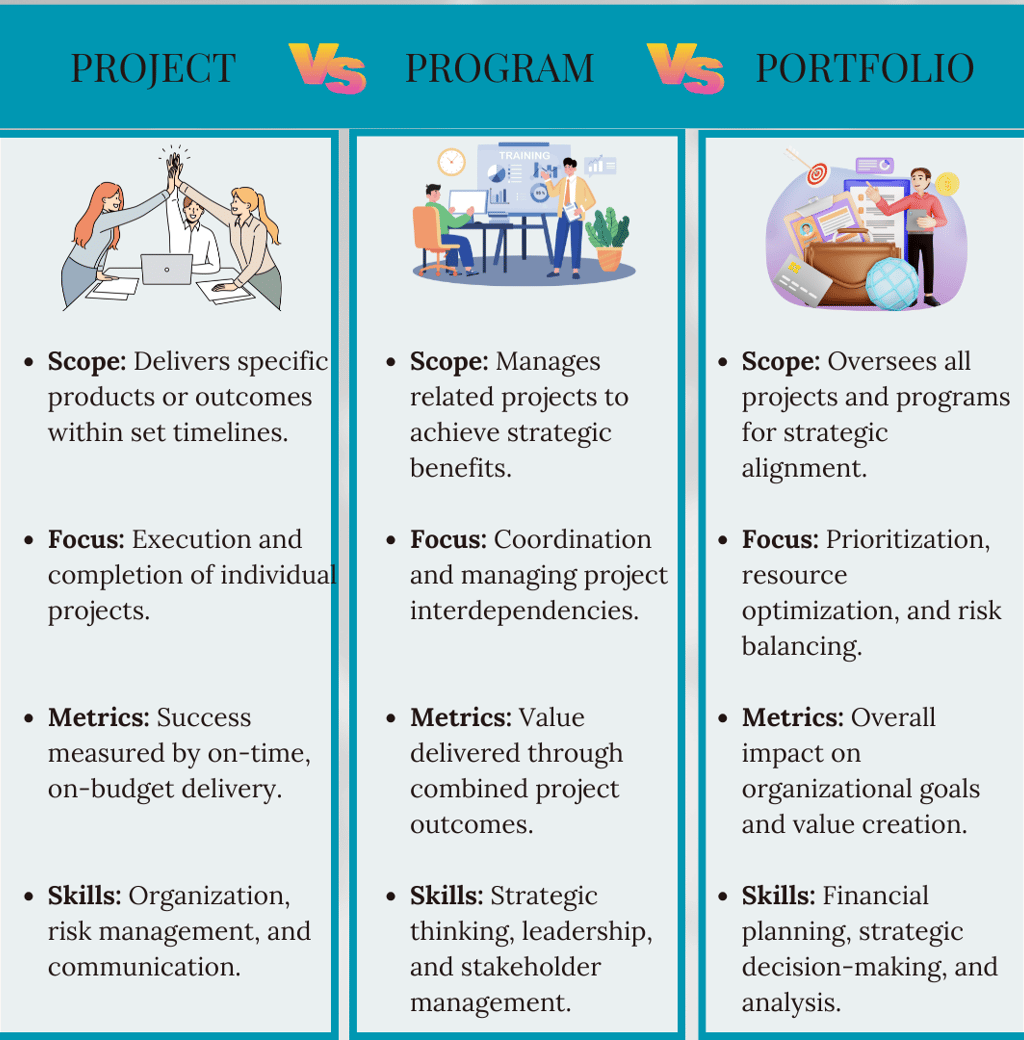Project Management vs. Program Management vs. Portfolio Management: Understanding the Differences
Understanding the distinctions between project, program, and portfolio management is more than just semantics; it’s a strategic advantage. Discover how each approach contributes to organizational success and when to use them for maximum impact.
Iyanna Trimmingham
11/4/20244 min read


In organizational leadership, not all management roles are created equal. Project management, program management, and portfolio management represent three distinct yet interconnected disciplines that play pivotal roles in driving a company’s success. Misunderstanding or blurring these roles can lead to inefficiencies and even missed opportunities.
Why is it crucial to grasp the differences?
Because each approach requires unique strategies, focuses on different outcomes, and aligns with specific organizational goals. Leaders who understand these distinctions can better allocate resources, manage risks, and achieve both immediate and strategic objectives.
This article will clarify what makes each discipline unique, outline their core responsibilities, and explain when to apply each one for maximum impact. By deepening your understanding, you'll be prepared to choose the right management approach for any organizational challenge.
Project Management
Definition and Scope: Project management involves applying knowledge, skills, tools, and techniques to execute a project successfully. Projects are temporary endeavors with specific goals, often involving a defined scope, budget, and timeline.
Key Responsibilities of a Project Manager: Project managers are responsible for planning, executing, and closing projects. Their duties include defining project objectives, managing the team, mitigating risks, and ensuring the project is completed on time and within budget.
Examples of Projects: Examples include developing a new product, launching a marketing campaign, or constructing a building. Each project has clear deliverables and a defined endpoint.
Skills and Competencies: Successful project managers possess strong organizational skills, communication abilities, and expertise in risk management and scheduling. They are adept at using project management tools like Gantt charts and Agile methodologies.
Program Management
Definition and Scope: Program management is the practice of managing multiple related projects in a coordinated way to achieve strategic benefits. Programs are often ongoing and can adapt as organizational needs change.
Key Responsibilities of a Program Manager: A program manager ensures that projects are aligned and deliver collective benefits. They manage interdependencies between projects, allocate resources, and align outcomes with strategic goals.
Managing a Program vs. a Project: While project managers focus on specific deliverables, program managers oversee a broader set of projects to achieve long-term objectives. For example, launching a new product line may involve several projects, from product development to market analysis.
Skills and Competencies: Program managers require strategic thinking, stakeholder management, and the ability to balance complex interdependencies. They must also be skilled at conflict resolution and change management.
Portfolio Management
Definition and Scope: Portfolio management involves overseeing a collection of projects and programs to achieve strategic objectives. The goal is to optimize resource allocation and ensure that investments deliver maximum value.
Key Responsibilities of a Portfolio Manager: Portfolio managers evaluate and prioritize projects and programs based on their strategic alignment and potential return on investment (ROI). They continuously assess the portfolio's performance and make adjustments to stay aligned with the organization’s strategic goals.
Alignment with Strategy: Unlike project or program management, portfolio management is about making strategic decisions that benefit the organization as a whole. For example, a tech company may have a portfolio consisting of various R&D projects, infrastructure upgrades, and market expansion initiatives.
Skills and Competencies: Portfolio managers need strong analytical skills, financial acumen, and an ability to align projects with business strategy. They must also be effective at communication and risk management.
Key Differences
Scope:
Project Management: Focuses on specific deliverables with a clear end date.
Program Management: Manages a set of related projects for long-term benefits.
Portfolio Management: Aligns projects and programs with the organization’s strategic goals.
Objectives:
Project: Deliver a unique product, service, or result.
Program: Achieve greater benefits through coordinated project efforts.
Portfolio: Maximize value by strategically selecting and managing projects and programs.
Management Focus:
Project Manager: Execution and delivery of individual projects.
Program Manager: Coordination and strategic alignment of multiple projects.
Portfolio Manager: Strategic decision-making and resource optimization.
Interdependencies:
Projects may be independent or interlinked within a program.
Programs manage dependencies among projects.
Portfolios balance resources and priorities across the organization.
Metrics and Success Criteria:
Project: Measured by on-time, on-budget delivery.
Program: Evaluated by the overall benefits achieved.
Portfolio: Success is measured by strategic alignment and return on investment.
Benefits of Each Management Type
Project Management: Ensures that individual projects are executed efficiently, with a focus on meeting deadlines and budgets.
Program Management: Provides better coordination of related projects, resulting in strategic advantages and more efficient resource use.
Portfolio Management: Enhances strategic alignment, optimizes resource allocation, and drives overall organizational success.
Challenges and Solutions
Project Management Challenges: Issues like scope creep, resource constraints, and tight deadlines are common.
Solution: Use clear project planning, scope control, and adaptive methodologies.
Program Management Challenges: Managing interdependencies and balancing stakeholder expectations can be difficult.
Solution: Establish strong governance and continuous communication.
Portfolio Management Challenges: Balancing competing priorities and adapting to strategic shifts is challenging.
Solution: Employ dynamic portfolio analysis and stakeholder alignment.
Practical Applications and Case Studies
Project Management: A software company that successfully launched a new app on time by using Agile methodologies.
Program Management: A government agency’s coordinated efforts to improve public transport involved multiple projects, from infrastructure upgrades to digital ticketing systems.
Portfolio Management: A multinational corporation streamlined its investments by focusing on projects that aligned with its sustainability goals, enhancing overall performance.
Conclusion
Project management, program management, and portfolio management each play a critical role in achieving organizational success. Project management ensures tasks are completed efficiently, program management coordinates multiple projects for strategic benefits, and portfolio management aligns all initiatives with overarching business goals. By understanding these differences, leaders can make informed decisions, ensuring that their resources are used effectively, and their strategies are successful.
As organizations grow more complex, the ability to leverage all three management types becomes essential. Developing skills in project, program, and portfolio management will empower you to navigate challenges, drive innovation, and deliver sustainable results. So, which management style will you master to propel your organization forward?
Think about where your organization stands today—and how a deeper understanding of these management disciplines can shape a more strategic, effective, and successful future.

